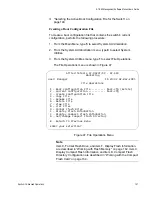
Chapter 9: File System
154
Section II: Advanced Operations
Copying a System File
This procedure is used to create copies of files stored in a switch’s file
system or on a flash memory card. For instance, you might perform this
procedure to create a copy of a configuration file so that you have a
backup copy.
You can also use this procedure is to copy files between a switch’s file
system and a flash memory card. For example, you might want to copy a
configuration file from a flash card to a switch’s file system, or perhaps
copy an SSL enrollment request from the switch to a compact flash card.
Before performing the procedure, note the following:
To copy a file on a compact flash card, you must first change to the
directory where the file is stored or, if you are copying a file to the card
from the switch’s file system, where you want to store the file. This is
explained in “Changing the Current Flash Card Directory” on
page 166. The following procedure does not allow you to specify a
directory path. The default location is the root of the flash card.
Files with the extension UKF are encryption key pairs. These files
cannot be copied, renamed, or deleted from the file system.
To copy a system file, perform the following procedure:
1. From the Main Menu, type
5
to select System Administration.
2. From the System Administration menu, type
9
to select System
Utilities.
3. From the System Utilities menu, type
1
to select File Operations.
The File Operations menu is shown in Figure 47 on page 147.
4. From the File Operations menu, type
4
to select Copy File.
Note
Selecting Copy File does not allow you to overwrite files.
The following prompt is displayed:
Enter the source file name:
5. Enter the name of the file to be copied. If the file is located on a
compact flash card, precede the filename with “cflash:”
The following prompt is displayed:
Enter the destination file name:
Summary of Contents for AT-9400
Page 16: ...Figures 16 ...
Page 18: ...Tables 18 ...
Page 28: ...Preface 28 ...
Page 30: ...30 Section I Basic Operations ...
Page 60: ...Chapter 1 Basic Switch Parameters 60 Section I Basic Operations ...
Page 64: ...Chapter 2 Port Parameters 64 Section I Basic Operations Port Type The port type ...
Page 84: ...Chapter 2 Port Parameters 84 Section I Basic Operations ...
Page 124: ...Chapter 6 Static Port Trunks 124 Section I Basic Operations ...
Page 144: ...144 Section II Advanced Operations ...
Page 196: ...Chapter 10 File Downloads and Uploads 196 Section II Advanced Operations ...
Page 218: ...Chapter 11 Event Logs and the Syslog Client 218 Section II Advanced Operations ...
Page 242: ...Chapter 13 Access Control Lists 242 Section II Advanced Operations ...
Page 294: ...294 Section III IGMP Snooping MLD Snooping and RRP Snooping ...
Page 314: ...Chapter 19 MLD Snooping 314 Section III IGMP Snooping MLD Snooping and RRP Snooping ...
Page 318: ...318 Section IV SNMPv3 ...
Page 416: ...Chapter 21 SNMPv3 416 Section IV SNMPv3 ...
Page 418: ...418 Section V Spanning Tree Protocols ...
Page 470: ...470 Section VI Virtual LANs ...
Page 520: ...Chapter 26 Multiple VLAN Modes 520 Section VI Virtual LANs ...
Page 532: ...Chapter 27 Protected Ports VLANs 532 Section VI Virtual LANs ...
Page 546: ...546 Section VII Internet Protocol Routing ...
Page 560: ...560 Section VIII Port Security ...
Page 568: ...Chapter 30 MAC Address based Port Security 568 Section VIII Port Security ...
Page 586: ...Chapter 31 802 1x Port based Network Access Control 586 Section VIII Port Security ...
Page 588: ...588 Section IX Management Security ...
Page 610: ...Chapter 33 Encryption Keys 610 Section IX Management Security ...
Page 650: ...Chapter 36 TACACS and RADIUS Protocols 650 Section IX Management Security ...
Page 660: ...Chapter 37 Management Access Control List 660 Section IX Management Security ...
Page 668: ...Index 668 ...






























